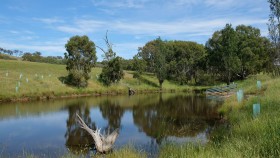Fenner researchers working to improve real-time rainfall information for India
Researchers from Fenner’s Centre for Water and Landscape Dynamics (WALD) are collaborating with India’s premier weather forecasting agency to provide new and improved real-time rainfall information for India.
Dr Luigi Renzullo leads the project, along with Dr Pablo Larraondo and Prof Albert Van Dijk, to develop the underpinning science behind a new rainfall prediction capability for India. The project funded by the Indian Institute of Tropical Meteorology brings together the WALD team, researchers from our Bureau of Meteorology, and India’s National Centre for Medium Range Weather Forecasting (NCMRWF), a centre of excellence in numerical weather prediction research.
“The NCMRWF became aware of our earlier work on multi-source rainfall blending for Australia, done in collaboration with the Bureau of Meteorology”, Dr Renzullo said. “They are particularly keen to see if some of the methods can be further developed and tested in India, and ultimately lead to new rainfall information products for India.”
Real-time rainfall information, such as the amount and extent rainfall that occurred just a few minutes ago, serves as a much needed heads-up to emergency services and the public in general to warn and safeguard against potentially severe weather, including flash flooding.
Existing rainfall data which include rain gauges, weather radar, satellite and numerical weather prediction (NWP) have limitations by themselves. By merging these different data sources using sophisticated mathematical methods such as machine learning techniques, the WALD team have shown that the blended rainfall product (called an ‘analysis’) has better accuracy and coverage than individual data sets.
"By merging multiple sources of rainfall data, we often do better than any single data source – the whole ‘wisdom of the crowd’ thing. But more importantly, the deficiencies in any one source are mitigated by the strengths of the others, resulting in an overall improved rainfall analysis," Dr Renzullo said.
Supercomputing forms an integral part of the rainfall research. “Storage alone of the massive volumes of data from ground networks --- rain gauges and radars--- satellite observations and NWP is one thing, but the computing resources to generate our merged rainfall analysis, with all the data processing and manipulation, can be quite mind blowing.
“The methods we develop have to work in real-time across large geographic areas – the continent, for example – to merge large volumes of rainfall data in the order of minutes. One way of doing this to distribute the computational effort across a thousand or so nodes,” Dr Renzullo said.
The NCMRWF have a Cray supercomputer available for their work (the computer was listed 51st in the world’s Top500 listing in 2018). When the research at WALD has demonstrate through a prototype system how the merging of multiple sources of data will be achieved to provide real-time rainfall analyses, work will begin to transition the system to the NCMRWF.
 Photo: National Centre for Medium Range Weather Forecasting (NCMRWF) in Noida, India.
Photo: National Centre for Medium Range Weather Forecasting (NCMRWF) in Noida, India.









